Step into the enchanting world of owls in Missouri, where these majestic creatures soar through the night with an air of timeless wisdom. As you journey through this article, you will be introduced to a diverse array of eight owl species, each with their own unique characteristics and captivating presence.
From the haunting call of the Great Horned Owl to the stealthy hunting techniques of the Snowy Owl, prepare to be immersed in a realm where feathers and night skies intertwine.
So, if you’re ready to uncover the secrets of these magnificent creatures and explore the intricate tapestry of their lives, join us as we embark on a fascinating exploration of Owls in Missouri.
Great Horned Owl: Identification & Facts
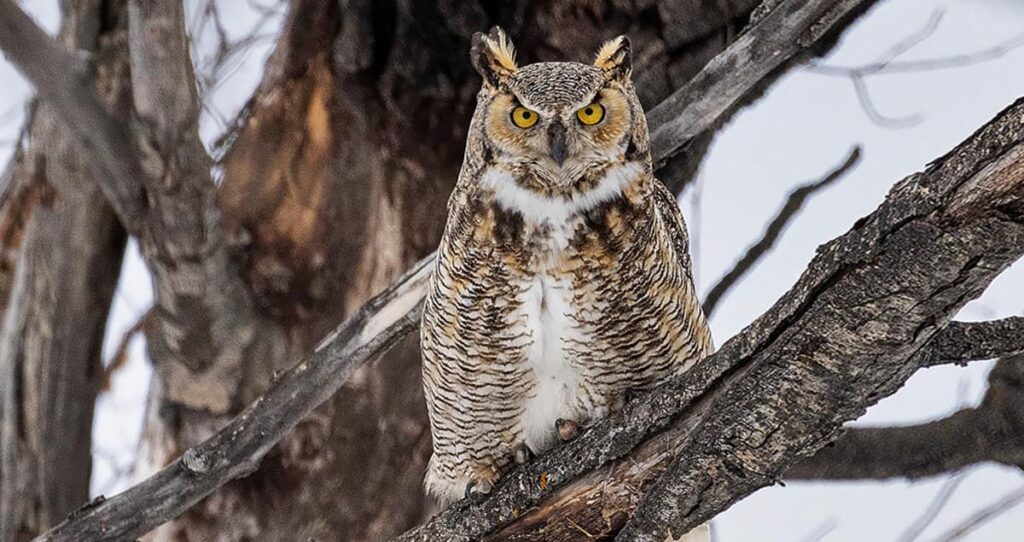
The Great Horned Owl, with its distinctive large size and prominent ear tufts, is a formidable predator found in Missouri’s deciduous woods, secondary-growth woodlands, and even urban areas. This owl, scientifically known as Bubo virginianus, measures about 18.1 to 24.8 inches in length and weighs between 910 to 2500 grams. With a wingspan ranging from 39.8 to 57.1 inches, it commands an impressive presence in the sky. The Great Horned Owl’s habitat includes a variety of environments, making it a versatile hunter.
Despite its name, the Great Horned Owl’s ‘horns’ aren’t really horns at all, but rather tufts of feathers that resemble ears. These ear tufts are used for display and communication, making them a distinguishing feature of this owl. With its keen eyesight and exceptional hearing, the Great Horned Owl is well-equipped to hunt its prey, which includes rodents, small mammals, birds, and even other owls.
When it comes to interactions with humans, the Great Horned Owl prefers to keep its distance. It isn’t naturally friendly towards people and shouldn’t be touched, petted, or handled. Even captive birds exhibit discomfort around humans, so it’s best to admire them from afar.
Eastern Screech Owl: Identification & Facts
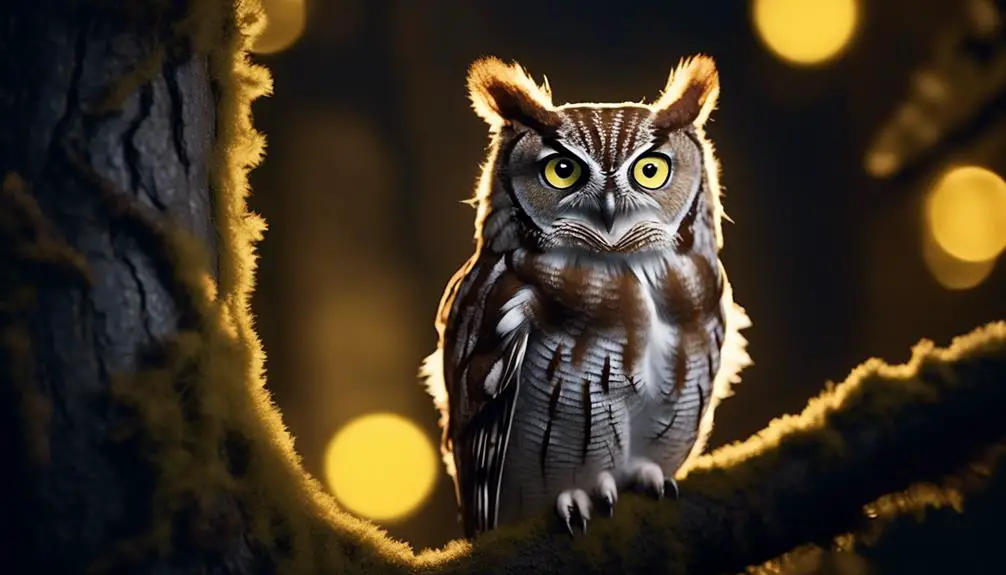
Moving on from the Great Horned Owl, let’s now explore the fascinating world of the Eastern Screech Owl and uncover its unique identification characteristics and intriguing facts.
The Eastern Screech Owl, scientifically known as Megascops asio, measures around 6.3 to 9.8 inches in length and weighs between 121 to 244 grams. Its wingspan ranges from 18.9 to 24.0 inches. This owl species can be found in woods, forests, and tree cavities near water sources.
The Eastern Screech Owl has two distinct color morphs: red and gray. The red morph has a reddish-brown plumage with vertical streaks, blending well with the bark of trees. On the other hand, the gray morph has a grayish-brown plumage with intricate patterns, providing camouflage against tree bark. Both morphs have bright yellow eyes.
Despite its name, the Eastern Screech Owl doesn’t screech but instead produces a variety of calls. Its primary call is a haunting trill, which can be described as a descending whinny. Additionally, it can emit soft, monotonic whistles and short, high-pitched trills. These vocalizations are used for territorial defense and courtship.
Eastern Screech Owls are primarily nocturnal hunters, feeding on insects, small mammals, birds, and amphibians. They have excellent hearing and vision, allowing them to locate prey accurately. Their diet consists mainly of mice, voles, and insects like moths and beetles.
Eastern Screech Owls are cavity nesters, utilizing natural tree cavities or man-made nest boxes. They lay 3 to 6 eggs and incubate them for approximately 26 to 28 days. The young owlets leave the nest after about 30 days but remain dependent on their parents for several weeks.
Barn Owl: Identification & Facts
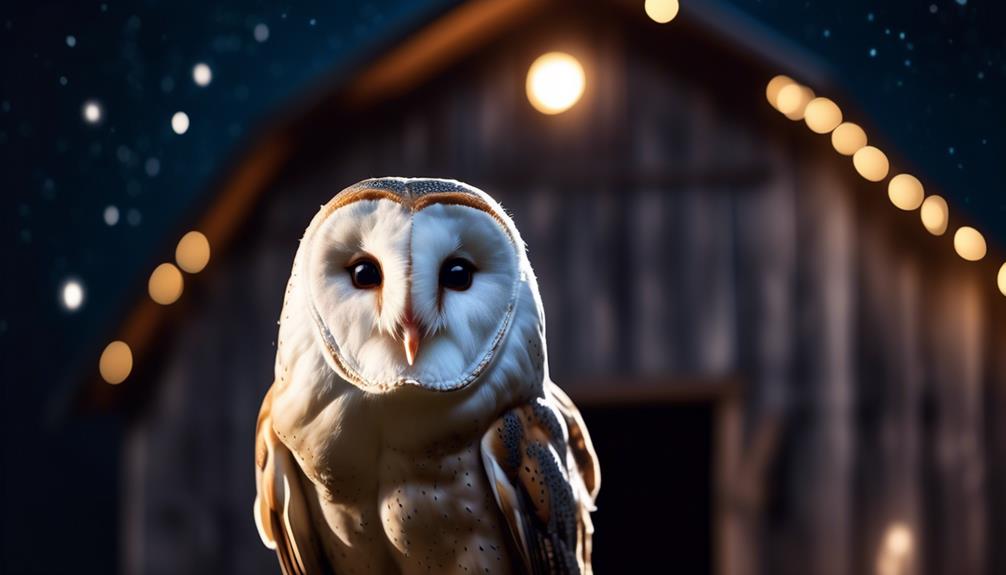
To delve into the intriguing world of the Barn Owl and uncover its unique identification characteristics and fascinating facts, let’s now explore this captivating subtopic.
The Barn Owl, scientifically known as Tyto alba, is a medium-sized owl that measures between 12.6 and 15.8 inches in length and weighs between 400 and 700 grams. Its wingspan can range from 99.1 to 114.3 centimeters.
One of the distinctive features of the Barn Owl is its heart-shaped face, which is pale and lacks ear tufts. Its feathers are a beautiful mix of white, tan, and brown, with a mottled pattern that provides excellent camouflage in its preferred habitat.
Speaking of habitat, the Barn Owl is commonly found in man-made buildings such as barns, chimneys, and steeples. It’s a nocturnal hunter, preferring to hunt small mammals like mice and voles.
Despite its silent flight, the Barn Owl has a distinctive screeching call that can be heard at night. It’s truly a remarkable species to observe in the wild.
Barred Owl: Identification & Facts
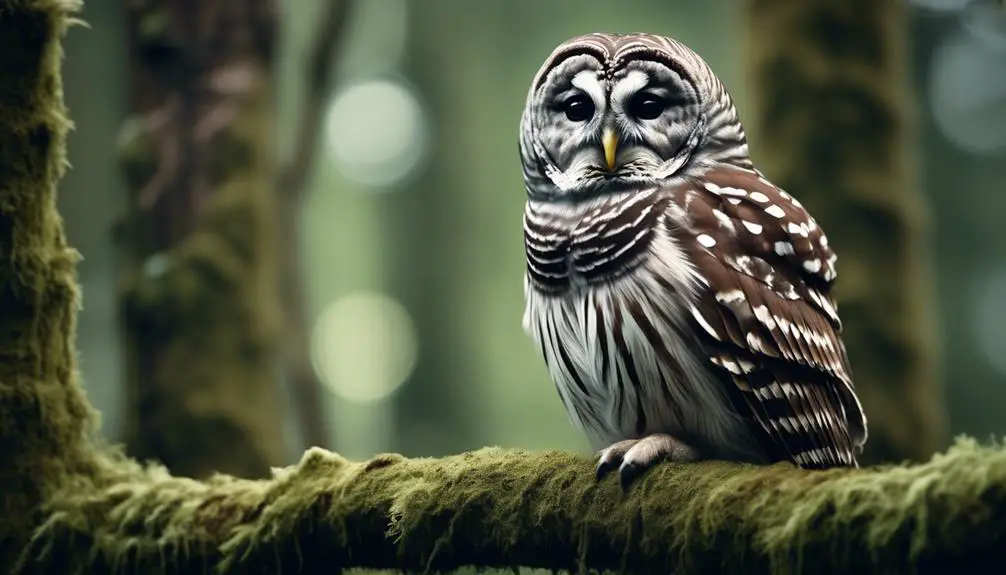
Let’s now delve into the fascinating world of the Barred Owl and discover its unique identification characteristics and interesting facts.
The Barred Owl, scientifically known as Strix varia, is a medium-sized owl measuring between 16.9 to 20.1 inches in length and weighing around 470 to 1050 grams. It has a wingspan of 96 to 125 centimeters.
One of the most distinctive features of the Barred Owl is its barred plumage pattern on the chest and belly, which gives it its name. The bars are vertical and brown, contrasting against a white background. Its head is round with dark brown eyes and lacks ear tufts. Its beak is yellowish and hooked, ideal for tearing apart prey.
Barred Owls can be found in wooded areas near water bodies, making them excellent hunters of fish, amphibians, and small mammals. They’re primarily nocturnal, relying on their excellent hearing to locate prey in the dark. Their call is a series of eight hoots that sound like ‘Who cooks for you? Who cooks for you all?’
These owls are territorial and form strong pair bonds. They nest in tree cavities and are known to displace other bird species from their nests. Barred Owls are adaptable and can live in various habitats, including suburban areas. They’re a true marvel to observe in the wild.
Northern Saw-Whet Owl: Identification & Facts

The Northern Saw-Whet Owl, scientifically known as Aegolius acadicus, is a small owl species found in Missouri. It has a length ranging from 7.1 to 8.3 inches and a weight of 65 to 151 grams. This little owl has a wingspan of 16.5 to 18.9 inches and is often found in dense evergreen forests and tree cavities.
The Northern Saw-Whet Owl is known for its elusive nature, making it difficult to spot. It has a round head with bright yellow eyes and brown and white streaked feathers on its body.
This owl species is primarily active at night and has a diet consisting of small mammals, birds, and insects. Despite its small size, the Northern Saw-Whet Owl has a strong hunting ability and is able to catch prey with precision.
Its call is a high, repetitive tooting sound, similar to the noise made by a saw being sharpened, hence its name. The Northern Saw-Whet Owl is a fascinating and unique species that adds to the diversity of owls found in Missouri.
Long-Eared Owl: Identification & Facts

Now let’s turn our attention to the Long-Eared Owl, another intriguing owl species found in Missouri. The Long-Eared Owl, scientifically known as Asio otus, is a medium-sized owl that measures between 13.8 and 15.8 inches in length and weighs between 220 and 435 grams. It has a wingspan ranging from 35.4 to 39.4 inches. One distinguishing feature of this owl is its long ear tufts, which give it its name. It also has a buff or orange face and dark plumage.
Long-Eared Owls aren’t commonly seen in Missouri and are typically visible from mid-November to mid-April. They prefer to roost collectively in dense pine groves and are solitary during the day. These owls have a diet that mainly consists of small mammals, such as mice and voles, but they also feed on birds and insects. Long-Eared Owls are known for their excellent hearing, which allows them to locate prey in the dark.
It is important to note that Long-Eared Owls, like all owls, aren’t naturally friendly towards humans. They shouldn’t be touched, petted, or handled, even if they’re captive birds. These owls prefer to maintain their distance from humans and may exhibit discomfort when in close proximity to them.
Snowy Owl: Identification & Facts
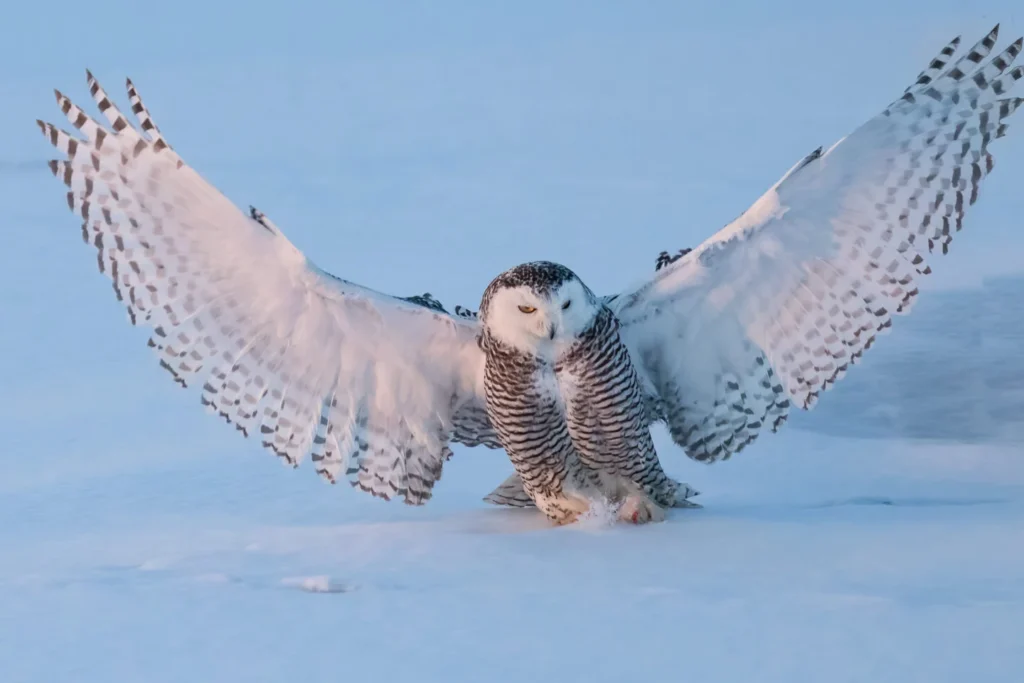
To learn about the Snowy Owl, let’s explore its identification and fascinating facts.
Snowy Owls are large, majestic birds with a wingspan ranging from 49.6 to 57.1 inches. They measure between 20.5 and 27.9 inches in length and weigh between 1600 and 3200 grams. These beautiful owls have a distinctive appearance, with their pure white plumage and piercing yellow eyes.
In terms of habitat, Snowy Owls prefer Arctic regions, but they occasionally visit Missouri during the winter months.
Snowy Owls are known for their silent and reserved nature. They’ve unique alarm sounds that are used to communicate with other owls and warn of potential dangers. In terms of behavior, Snowy Owls are skilled hunters. They’ve excellent eyesight and can spot prey from great distances. Their diet mainly consists of small mammals such as lemmings, voles, and rabbits. Snowy Owls are also known to eat birds and fish when necessary.
These owls are truly remarkable creatures, and their presence in Missouri during the winter months is a rare and special opportunity to observe them in their natural habitat.
Short-Eared Owl: Identification & Facts

Continuing our exploration of owls, let’s now turn our attention to the Short-Eared Owl and uncover its unique identification and fascinating facts.
The Short-Eared Owl, scientifically known as Asio flammeus, is a medium-sized owl that measures about 13.4 to 16.9 inches in length and weighs between 206 to 475 grams. With a wingspan ranging from 33.5 to 40.5 inches, this owl can be identified by its mottled brown and white plumage, as well as its distinct facial disk and yellow eyes.
Unlike most owls, the Short-Eared Owl is diurnal, meaning it hunts during the daytime. It can be found in Missouri’s Glaciated Plains, Mississippi Lowlands, and Osage Plains, where it roosts in grassy, dry streams.
When hunting, it flies with even, stiff beats and glides silently across open spaces. Although not particularly vocal, the Short-Eared Owl can bark, scream, and whine when defending its nest.
In Missouri, the Short-Eared Owl is considered a rare species. Its presence is often associated with the decline of native prairies and grasslands. By hunting rodents and small mammals, the Short-Eared Owl plays a crucial role in balancing the ecosystem.

Erzsebet Frey (Eli Frey) is an ecologist and online entrepreneur with a Master of Science in Ecology from the University of Belgrade. Originally from Serbia, she has lived in Sri Lanka since 2017. Eli has worked internationally in countries like Oman, Brazil, Germany, and Sri Lanka. In 2018, she expanded into SEO and blogging, completing courses from UC Davis and Edinburgh. Eli has founded multiple websites focused on biology, ecology, environmental science, sustainable and simple living, and outdoor activities. She enjoys creating nature and simple living videos on YouTube and participates in speleology, diving, and hiking.
